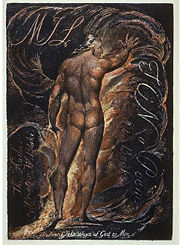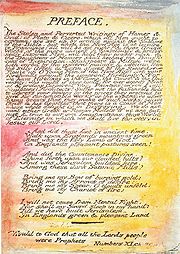
Milton: a Poem
Encyclopedia

William Blake
William Blake was an English poet, painter, and printmaker. Largely unrecognised during his lifetime, Blake is now considered a seminal figure in the history of both the poetry and visual arts of the Romantic Age...
, written and illustrated between 1804 and 1810. Its hero is John Milton
John Milton
John Milton was an English poet, polemicist, a scholarly man of letters, and a civil servant for the Commonwealth of England under Oliver Cromwell...
, who returns from Heaven and unites with Blake to explore the relationship between living writers and their predecessors, and to undergo a mystical journey to correct his own spiritual errors.
Milton was Blake's longest published poem to date, and was printed in Blake's characteristic combination of etched text and illustration supplemented by watercolour.
Preface
The preface to Milton includes the poem "And did those feet in ancient timeAnd did those feet in ancient time
"And did those feet in ancient time" is a short poem by William Blake from the preface to his epic Milton a Poem, one of a collection of writings known as the Prophetic Books. The date on the title page of 1804 for Milton is probably when the plates were begun, but the poem was printed c. 1808...
", which became the lyrics for the hymn "Jerusalem". The poem appears after a long prose attack on the influence of Greek
Ancient Greece
Ancient Greece is a civilization belonging to a period of Greek history that lasted from the Archaic period of the 8th to 6th centuries BC to the end of antiquity. Immediately following this period was the beginning of the Early Middle Ages and the Byzantine era. Included in Ancient Greece is the...
and Roman
Roman Empire
The Roman Empire was the post-Republican period of the ancient Roman civilization, characterised by an autocratic form of government and large territorial holdings in Europe and around the Mediterranean....
culture, which is unfavourably contrasted with "the sublime of the Bible".

Text
The poem is divided into two "books".Book I opens with an epic invocation to the muses, drawing on the classical models of Homer
Homer
In the Western classical tradition Homer , is the author of the Iliad and the Odyssey, and is revered as the greatest ancient Greek epic poet. These epics lie at the beginning of the Western canon of literature, and have had an enormous influence on the history of literature.When he lived is...
and Virgil
Virgil
Publius Vergilius Maro, usually called Virgil or Vergil in English , was an ancient Roman poet of the Augustan period. He is known for three major works of Latin literature, the Eclogues , the Georgics, and the epic Aeneid...
, and also used by John Milton
John Milton
John Milton was an English poet, polemicist, a scholarly man of letters, and a civil servant for the Commonwealth of England under Oliver Cromwell...
in Paradise Lost
Paradise Lost
Paradise Lost is an epic poem in blank verse by the 17th-century English poet John Milton. It was originally published in 1667 in ten books, with a total of over ten thousand individual lines of verse...
. However, Blake describes inspiration in bodily terms, vitalising the nerves of his arm. Blake goes on to describe the activities of Los
Los (Blake)
In the mythological writings of William Blake, Los is the fallen form of Urthona, one of the four Zoas. He is referred to as the "eternal prophet" and creates the visionary city of Golgonooza. Los is regularly described as a smith, beating with his hammer on a forge, which is metaphorically...
, one of his mythological characters, who creates a complex universe from within which other Blakean characters debate the actions of Satan
Satan
Satan , "the opposer", is the title of various entities, both human and divine, who challenge the faith of humans in the Hebrew Bible...
.
Referring to the doctrines of Calvinism
Calvinism
Calvinism is a Protestant theological system and an approach to the Christian life...
, Blake asserts that humanity is divided into the "Elect", the "Reprobate" and the "Redeemed". Inverting Calvinist values, Blake insists that the "Reprobate" are the true believers, while the "Elect" are locked in narcissistic moralism. At this point Milton appears and agrees to return to earth to purge the errors of his own Puritanism and go to "Eternal death".
Milton travels to Lambeth
Lambeth
Lambeth is a district of south London, England, and part of the London Borough of Lambeth. It is situated southeast of Charing Cross.-Toponymy:...
, taking in the form of a falling comet, and enters Blake's foot. This allows Blake to treat the ordinary world as perceived by the five senses as a sandal formed of "precious stones and gold" that he can now wear. Blake ties the sandal and, guided by Los, walks with it into the City of Art, inspired by the spirit of poetic creativity.
Book II finds Blake in the garden of his cottage in Felpham
Felpham
Felpham is a village and civil parish in the Arun District of West Sussex, England. Although sometimes considered part of the greater Bognor Regis habitation it is a village and civil parish in its own right, having an area of 4.26 km² with a population of 9611 people and still growing .The...
. Ololon, a female figure linked to Milton, descends to meet him. Blake sees a skylark, which mutates into a twelve year old girl, who he thinks is one of his own muses. He invites her into his cottage to meet his wife. The girl states that she is actually looking for Milton. Milton then descends to meet with her, and in an apocalyptic scene he is eventually unified with the girl, who is identified as Ololon and becomes his own feminine aspect.
The poem concludes with a vision of a final union of living and dead; internal and external reality; male and female and a transformation of all of human perception.

